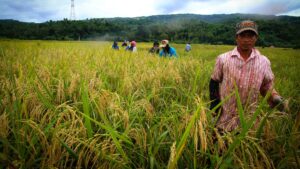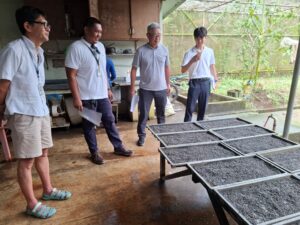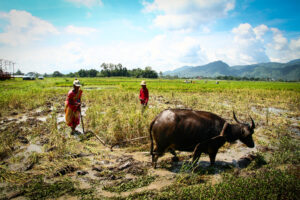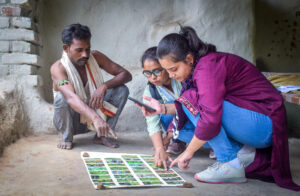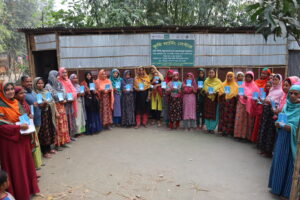by Bushra Humaira Sadaf, Md Abdul Haque, Abu Abdullah Miajy Sharif Ahmed, Humnath Bhandari
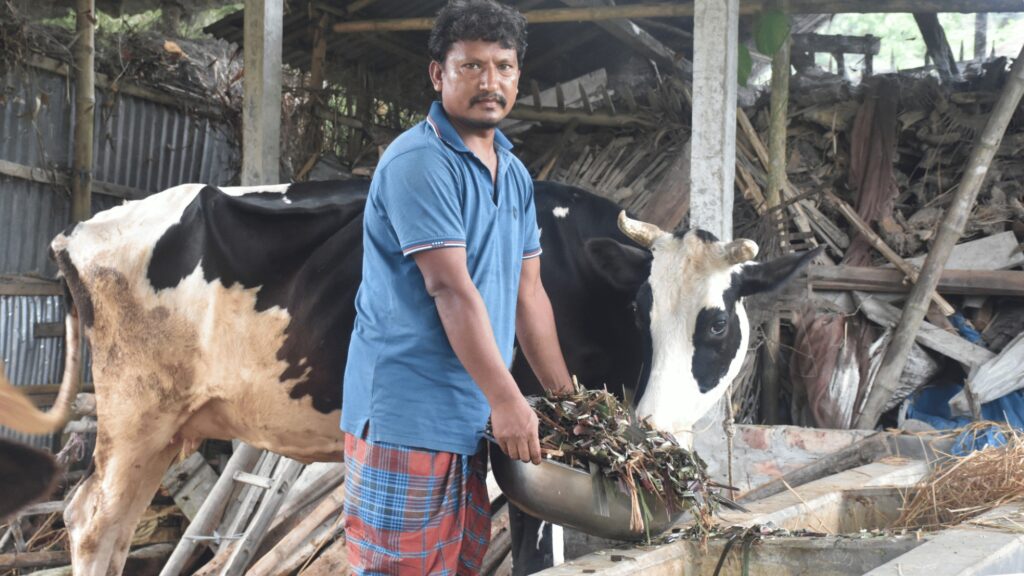
This article highlights Dilip Kumar Roy’s journey from struggling farmer to successful entrepreneur, showcasing the power of sustainable farming and support.
“People used to call me lazy and useless. I was unsuccessful in every aspect of my life and felt completely defeated,” says Dilip Kumar Roy, a 48-year-old farmer from Dharmopal village in Jaldhaka, Nilphamari in Bangladesh. “Now, those same people come to me for my advice about raising livestock. It feels good to be accepted in the community.”
Just a year ago, Dilip’s life looked very different. He struggled to support his wife, Smoroni Mohon Roy, and their two daughters on a limited income. With no formal training in farming or livestock management, he stuck to what he knew—growing rice, potatoes, and maize. He also reared five cows and some poultry birds, but the income from these wasn’t enough to cover his family’s expenses.
Things went from bad to worse when a duck-rearing venture he invested in failed miserably, wiping out much of his savings. “ I kept on making losses after losses,” Dilip recalls. “No matter what I tried, nothing seemed to work.”
A Fresh Start with Mixed Farming Systems
Then, in February 2023, Dilip joined the Mixed Farming Systems initiative under CGIAR and began receiving training on improved crop production and livestock management. The CGIAR Initiative on Mixed Farming Systems aims to boost yields without adversely impacting the environment. Along with other villagers, he received training on how to grow high-quality and high-yielding fodder crops like red Pakchong, Napier 3, Napier 4, and German White.
Dilip transformed about a thousand square meters of previously fallow land to cultivate fodder crops, which became a game-changer. Now, he no longer needs to buy expensive livestock feed, and his animals are healthier and more productive. What’s more, he can sell the excess fodder to his neighbors, generating an additional source of income by chopping and selling 10-15 kilograms of fodder each day at BDT 4 (USD 0.03) per kilogram. He has a diversified source of income after selling livestock, crops, fodder, and milk.
“This was a turning point for me,” Dilip said. “In six months, I made more income than I used to make in an entire year. Now, in 6 months, I earn around BDT 50,000 (USD 407), while before, I used to earn BDT 30,000 (USD 244) in one year.” His income has almost doubled.
His milk business has also become a steady income stream. Dilip sells 3-4 liters of milk daily at 50 taka (USD 0.41) per liter. “That money helps cover our daily needs,” he says. With the extra income, Dilip has opened a savings account with Grameen Sanchay, where he deposits a portion of his earnings every month. His goal is to save 3-4 lakh (USD 2,443-3,257) taka over the next few years to secure his family’s future.
Encouraged by his success, Dilip decided to expand his livestock business. He eventually added 16 goats. Dilip also ensured his goats had designated enclosures, preventing them from roaming freely and damaging his neighbors’ crops.
In addition to livestock, Dilip planted a homestead garden where he grows vegetables year-round for his family, cutting down on household expenses. He even started a vermicomposting project using cow dung, which he plans to scale up in the near future.
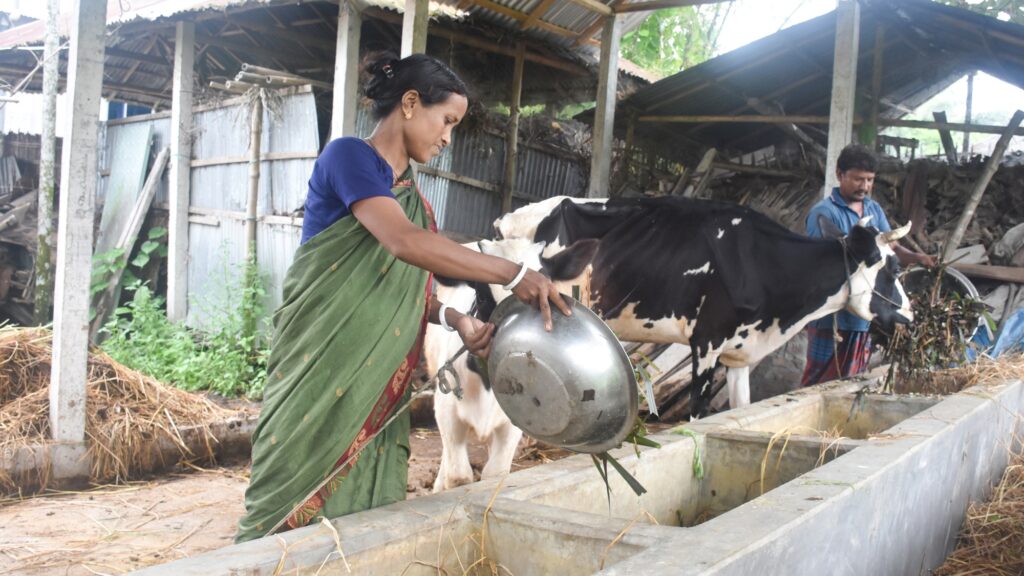
From Farmer to Entrepreneur
Dilip’s transformation from a struggling farmer to a thriving entrepreneur has inspired many in his village. People who once dismissed him as lazy now come to him for advice. His fodder-selling business has gained recognition in the community, and he has big plans for the future.
“I want to grow my business even more,” he says with a hopeful smile. “My goal is to raise 20 cows and 100 goats. I also want to learn more about livestock healthcare so I can treat my animals myself and reduce the losses from diseases.”
Dilip is also preparing for the upcoming Eid al-Adha season. He plans to sell 7 cows, which he hopes will bring a significant profit. His goats, which he sells for 5,000 to 6,000 BDT (USD 42-50) each after 6 months, are already a key part of his income.
Overcoming Challenges
However, the road hasn’t been without its challenges. Diseases occasionally affect his cows and goats, causing losses, and Dilip is eager to learn more about animal healthcare to prevent future issues. Still, he remains optimistic and reinvests all his earnings into his farm to ensure steady growth.
A Vision for the Future
Dilip’s ambitions don’t stop at his current successes. He is planning to revive his duck-farming venture—this time with better knowledge and resources to ensure it thrives. He’s also thinking about starting a fish farm in a nearby pond to diversify his income streams further.
As his business grows, Dilip is even considering hiring someone to help manage the farm so he can focus on scaling it up. “It’s exciting to think about what’s possible now,” he says.
Inspiration to the Community
Dilip’s story has made a big impact on his community. Once seen as someone who couldn’t manage his farm or finances, he’s now a respected role model. Several of his neighbors have started adopting similar farming practices, inspired by his success. “People who wouldn’t even lend me money before now come to me for advice,” he says with a smile.
“I used to struggle to afford basic things like healthcare for my family,” Dilip recalls. “Now, I have savings and a growing business. It feels like a new chapter of life.”
Looking Ahead
Dilip Kumar Roy is no longer just trying to survive—he’s thriving. With clear goals and a strong work ethic, he plans to continue growing his livestock business, invest in new ventures like fish and duck farming, and secure a better future for his family.
Through the support of CGIAR and his hard work, Dilip has transformed not only his own life but also the lives of those around him. His story is a powerful example of how sustainable farming and livestock management can lead to financial independence and a brighter future.

